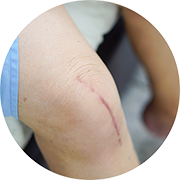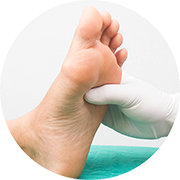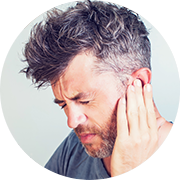

KNOW YOUR PAIN

POST-HERPETIC NEURALGIA
WHAT IS POST-HERPETIC NEURALGIA?
Post-herpetic neuralgia (PHN) is a complication of shingles. Shingles (also known as herpes zoster) is caused by an infection with the varicella zoster (chickenpox) virus, resulting in inflammation of nerve cells, and most cases clear up within a few weeks.1
Shingles can be very painful, but it is even worse if the pain continues after the visible shingles rash and blisters have disappeared.1 This pain after shingles is called PHN, and it is a type of neuropathic (nerve) pain that can continue for months or even years after the original infection.1,2
WHAT CAUSES POST-HERPETIC NEURALGIA?
PHN occurs if nerves are damaged due to a previous herpes zoster infection. Damaged nerves cannot correctly transmit signals from the skin to the brain.1
Approximately one in eight people above the age of 50 years old will develop PHN after shingles. The risk of PHN increases further with age.2
WHAT ARE TYPICAL SYMPTOMS OF POST-HERPETIC NEURALGIA?
The symptoms of PHN are very often limited or localised to the area of skin where the shingles outbreak first occurred.1 This is why PHN is often referred to as being a type of localised neuropathic pain.3
The chronic pain associated with PHN can be described as ‘burning pain’, ‘stabbing pain’, itching or aching. Patients with PHN often have hypersensitive skin, like a bad sunburn, and may feel severe pain from the touch of clothing on the affected area, a condition doctors call allodynia.1,4
HOW IS POST-HERPETIC NEURALGIA DIAGNOSED?
Doctors often have a difficult time diagnosing PHN, especially in people who have shingles but not the typical rash,4,5 so people need to tell their doctor if they have had a shingles infection in the past and now have chronic pain in the affected area.
Physical and neurological examinations are very important to help diagnose PHN. Part of the neurological examination is testing sensation in the affected area – this might be with a cotton bud, pinprick, hot and cold material, or pressure.5
The healthcare professional might also ask about pain intensity (using a pain scale), duration, frequency and other observations in your daily life. It is also important to describe your symptoms in as much detail as possible.6,7
WHAT CAN YOU DO?
With a correct diagnosis, early treatment might influence the course of PHN in a positive way.8 Alternatively, to reduce the chance of developing shingles, you can discuss a vaccination with a doctor.1
If you have chronic pain after shingles and think that it might be PHN, please fill out the My Pain Questionnaire and make an appointment to see a doctor. The My Pain Questionnaire is a useful tool to help with communicating pain more effectively with a doctor and supports them in making an accurate diagnosis of the cause of chronic pain. It will help with describing chronic pain, where it occurs on the body and if it is triggered by anything in particular. Once completed online, print out the results of the questionnaire and discuss them with a doctor.
In addition, the Pain Diary can be used to help document and keep track of a person’s pain condition; how they feel each day, whether they are coping, their current level of pain and any side effects of the treatment(s) prescribed/recommended.
Other kinds of pain
-
References
1. Weaver BA et al. J Am Osteopath Assoc. 2007;107:S2–7.
2. Johnson RW et al. Ther Adv Vaccines. 2015; 3:109–20.
3. Mick G et al. Pain Manag 2012;2:71–7.
4. Sampathkumar P et al. Mayo Clin Proc. 2009;84:274–280.
5. Nalamachu S & Morley-Forster P. Drugs and Aging 2012;29:863–9.
6. Morlion B et al. Curr Med Res Opin 2018;34:1169–78.
7. Kress HG, Aldington D, Alon E, et al. Curr Med Res Opin 2015;31:1743–54.
8. Bouhassira D et al. Pain 2012;153:342–9.



